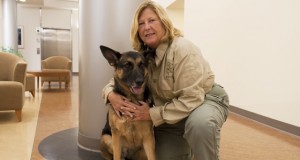
Teachers met many crime scene experts including Kristine Black and her dog Klaus, who volunteer with the Santa Clara County sheriff's K9 specialized search team. Kristine and Klaus are trained to help locate evidence at crime scenes, including bones and burial plots (photo by Elena Polanco).
By Amanda Holst, Public Affairs Assistant
An annual conference leveraging the popularity of the CSI TV series by offering workshops on forensic science to middle and high school teachers came to the West Coast for the first time ever this summer, hosted by the College of Applied Sciences and Arts.
“The beauty of this conference is that the people who are teaching the students are professionals who work at the crime scene and the crime lab,” said Professor of Justice Studies and Forensic Science Program Director Steven Lee. “These are the folks who know what the real crime scene is going to look like, and they really have the experience to share exercises that are going to be truly meaningful for our students.”
The American Academy of Forensic Sciences and the National Science Teachers Association developed the conference with the goal of strengthening overall science education in America. A 2000 study estimated that U.S. 12th graders ranked near the lowest out of 42 countries in math and science scores.
The SJSU Forensic Science Program and the Department of Justice Studies organized this year’s gathering, which took place July 14-16 at the Santa Clara County Crime Lab.
About 40 middle school and high school teachers attended the three-day conference, focusing on hands-on workshops and providing teachers valuable knowledge to bring back to their classrooms and labs. The conference also included “Think Tanks” held offsite, where teachers met to exchange ideas.
“It’s a chance to talk about bench practices and activities that work in their classrooms,” Lee said. “It’s a brainstorming between educators and experts in the field.”
Guest speakers included SJSU and CSU East Bay faculty from justice studies, forensic science, chemistry and anthropology. All the major fields of forensics were represented, including latent print identification, forensics toxicology (study of poison), and forensic anthropology (study of the human body and social relationships). Scientific disciplines included ballistic firearms, forensics K9, forensic crime scene reconstruction, and forensic chemistry, including the analysis of controlled substances.
The SJSU Forensics Program offers a B.S. Forensics Science with a concentration in biology, and a B.S. Forensic Science with a concentration in chemistry.

